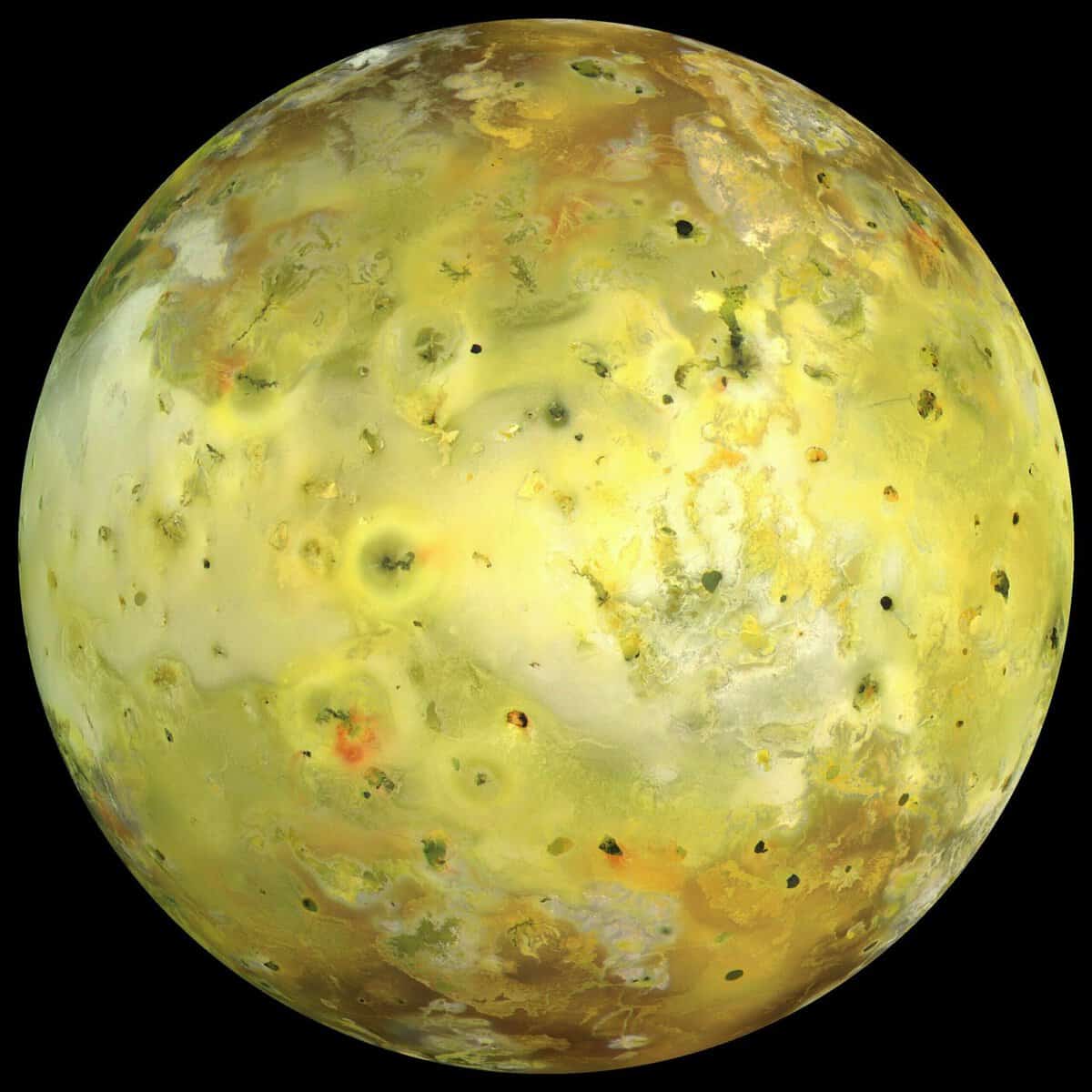Io, one of Jupiter’s moons, is named after Zeus’ mistress and is a fascinating and perilous celestial body that could easily be described as a version of hell. Io is part of the Galilean moons, a group of four satellites that are each distinct and offer unique worlds that can captivate even the most imaginative minds. And Io is no exception to this.
Some intriguing trivia about Io
Earthquakes and volcanic outbursts are already awe-inspiring on our planet, which is much larger than this diminutive satellite with a mere diameter of 1131 km. Yet, Io holds the distinction of being the most geologically active entity in the entire solar system! A multitude of cataclysms occur incessantly, with numerous volcanoes erupting and the terrain undergoing constant transformation.
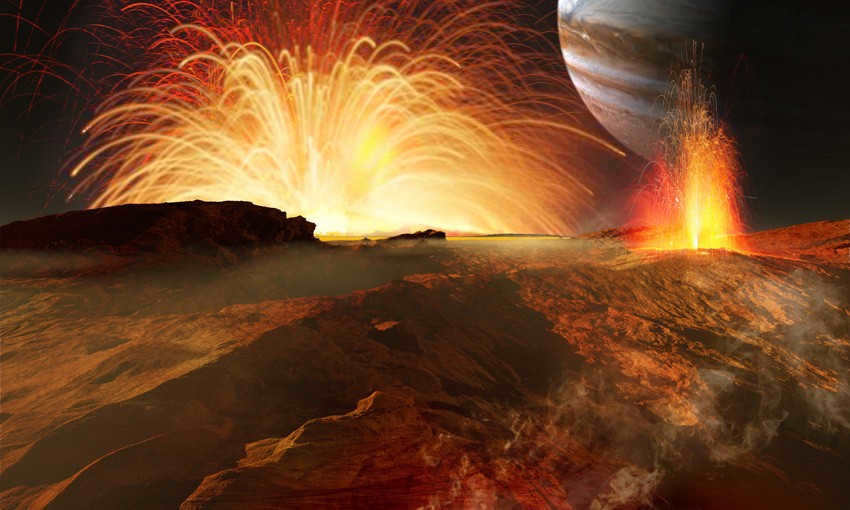
Among the Galilean satellites, Io holds the record for being the closest to Jupiter, with a distance of only 422 thousand kilometers, just a little more than the distance from Earth to the Moon. Io’s composition consists mainly of silicate rocks and iron, and it possesses a hot iron core. This sets it apart from most other satellites, which are typically lifeless chunks of rock or ice.
Due to the gravitational influence of Jupiter and other large satellites, Io experiences intense tidal forces, causing it to be constantly torn apart. If a small moon like ours can create tides on Earth, one can only imagine the cataclysms that a giant like Jupiter can unleash on Io.
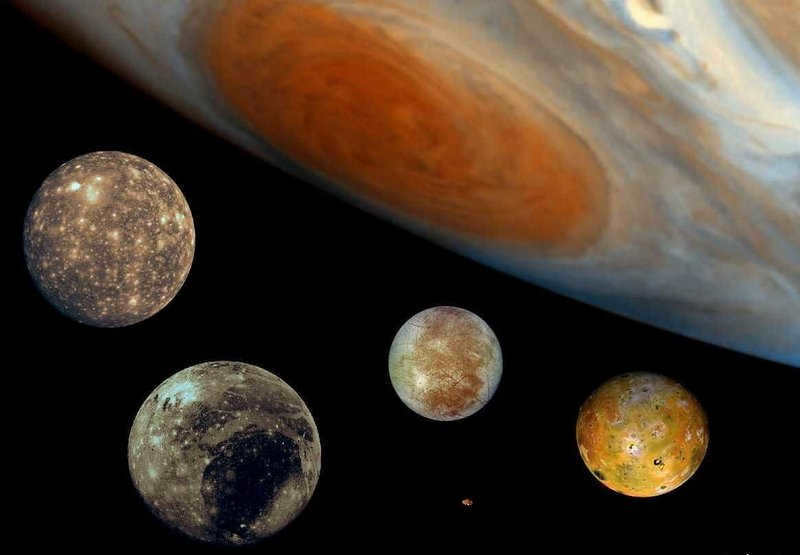
The Galilean satellites of Jupiter. Io is located on the right side.
These are just a few intriguing facts:
Io, one of Jupiter’s satellites, possesses remarkably large mountains considering its small size. Mount South Boosavla is twice as tall as Earth’s Jomolungma. These mountains are formed due to the compression of Io’s crust.
Io experiences constant volcanic eruptions, caused by the gravitational forces of Jupiter and other satellites. These volcanoes emit sulfur and its compounds, reaching heights of up to 500 kilometers. Moreover, traces of sulfur from Io can be found in the satellite’s orbit and even on other satellites like Europa, where it is present on the icy surface.
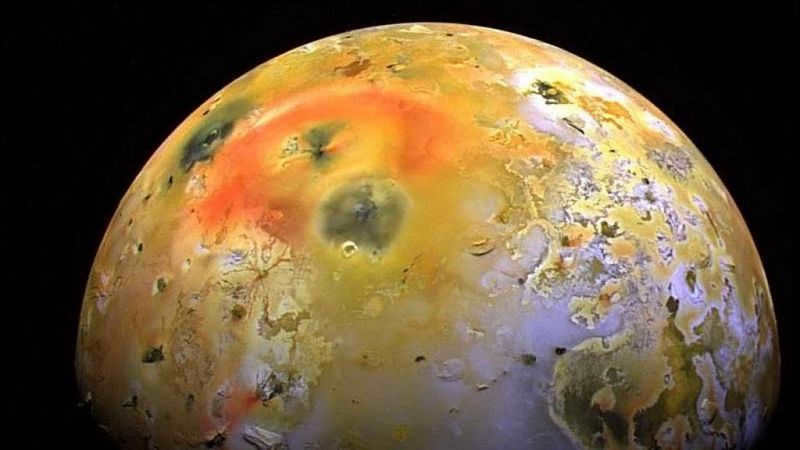
Io, a moon of Jupiter, experiences frequent volcanic eruptions that result in the formation of lava flows that spread up to 500 kilometers from the volcanoes. The unique sulfuric composition of Io’s surface gives it a striking color palette. The constant activity of volcanic eruptions, along with the deposition of lava and ash, leads to a dynamic and ever-changing landscape on Io. Additionally, seismic activity on the moon can create new mountain formations and flatten existing ones.
Not only do these eruptions shape the physical features of Io, but they also contribute to the creation of a thin atmosphere around the moon. Interestingly, this atmosphere occasionally gives rise to auroras.
A notable eruption at Twashtar Patera was captured by the New Horizons spacecraft in 2007.
Io, one of Jupiter’s moons, is an incredibly eerie and perilous yet strangely captivating celestial body. It is a realm characterized by flames and sulfur, resembling a quintessential depiction of hell, only this time, it’s for real.
Aside from Io and our own planet, no other active volcanoes have been detected anywhere within the solar system.
The finding of Io, one of Jupiter’s moons
In the year 1610, Galileo Galilei aimed his homemade telescope towards Jupiter and made an astonishing discovery. Initially, he only observed three moons, as Io and Europa appeared to be combined into a single entity and were indistinguishable. However, the following day, Galileo was able to clearly perceive that there were indeed four moons orbiting Jupiter. As a result, January 8, 1610 is recognized as the official date of Io’s discovery.
Interestingly, Galileo initially referred to this celestial body as Jupiter I, but it was later renamed Io by Simon Marius, who supported Johannes Kepler’s suggestion to name Jupiter’s moons after the mistresses of the god Zeus (Jupiter). However, these names were not widely adopted at that time, and it wasn’t until the mid-20th century that the moon came to be known as Io once again – prior to that, it was referred to as Jupiter I.
Interestingly, in mythology, Zeus took advantage of the young Io and then transformed her into a cow to conceal the incident from his wife, Hera.
Observing Io
For two centuries following the discovery of this moon, astronomers were unable to discern any details on its surface. It was only at the turn of the 19th-20th centuries that sufficiently powerful instruments were developed, allowing for some observations. Additionally, spectrographic and other studies helped to shed light on the nature of Io and confirm its volcanic activity. The most significant data and high-quality photographs were obtained through the use of space probes and telescopes.
The average amateur stargazer, armed with more modest equipment, will only perceive Io as a mere star. By the way, Io can be easily observed even with 8-10x binoculars, as long as the satellite is at a sufficient distance from Jupiter and does not merge with it. With even a relatively modest telescope, it is not difficult to distinguish all four Galilean satellites.
An 80-mm refractor with high-quality optics enables one to witness the shadows of the satellites crossing Jupiter’s disk. A larger instrument would allow for the observation of differences in the sharpness of these shadows. This close-up view of the process can be quite fascinating. Occasionally, it is possible to witness double or even triple shadow crossings. Additionally, one can observe the hue of the satellite – Io appears yellow due to its abundant sulfur content.
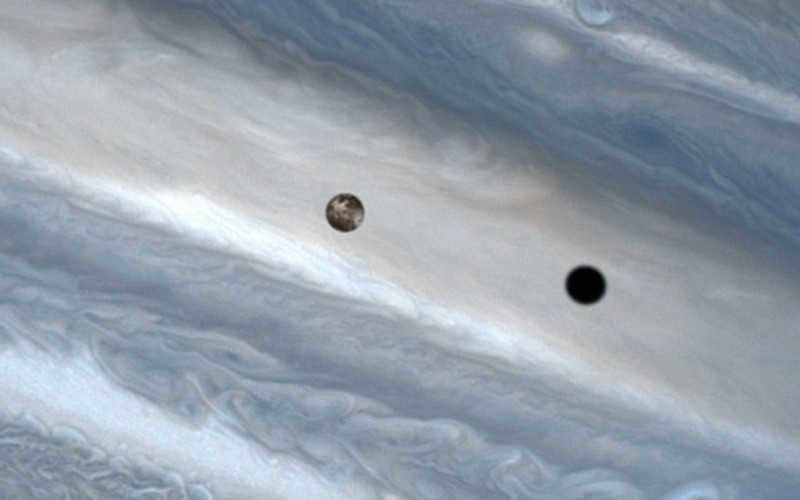
The satellite passing against the backdrop of Jupiter
During the opposition, it is possible to witness the simultaneous passage of the satellites and their shadows across the surface of Jupiter. Observing them against the sky is more challenging due to the incomplete phase and dark background.
Io is ranked as the second-largest moon and is considered to be the innermost moon in the Galilean group. This celestial body was first discovered by Galileo Galilei in 1610. The discovery of Io, along with Ganymede, Europa, and Callisto, provided evidence that the Earth is not the center of the universe, the Milky Way, or even the home system, as the satellites do not orbit around us but rather around another planet.
Io is sometimes known as the “pizza moon” due to its unique speckled landscape. It is also referred to as the fire and ice satellite because despite being far from the Sun, it emits a significant amount of heat at low temperatures. This moon is truly an otherworldly volcanic realm, unlike anything else in our solar system.
Originally named Jupiter I by Galileo, this moon was later given its current mythological name in the 1850s. In Greek mythology, Io was the mistress of Zeus. To avoid being discovered by Hera, she transformed herself into a cow. Now, let’s delve into the top ten fascinating facts about this extraordinary satellite.
Devoid of water
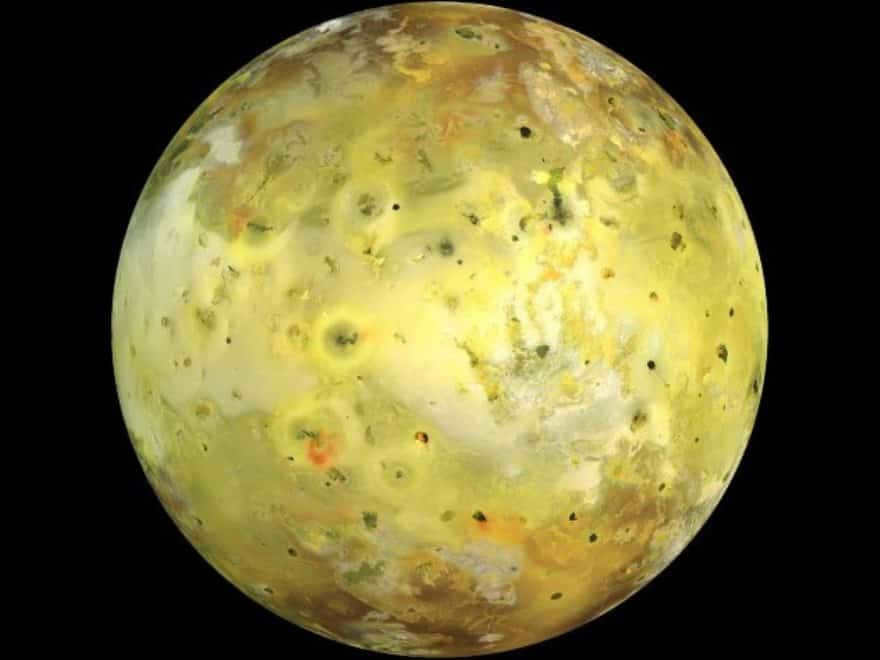
Here is one of the most arid regions in the entire solar system. Initially, when it was formed in the vicinity of Jupiter, this celestial body existed in an area abundant with water ice. It is believed that water was present during its early stages. However, over time, all of its water reserves gradually disappeared as a result of the intense bombardment of Jupiter’s radiation.
The possibility of past life cannot be disregarded. If there were organisms, they may have thrived at significant depths beneath the satellite’s surface. Therefore, if you plan on relocating to Io, it will be necessary to construct an underground tunnel in order to shield yourself from the radiation.
Colossal volcanoes
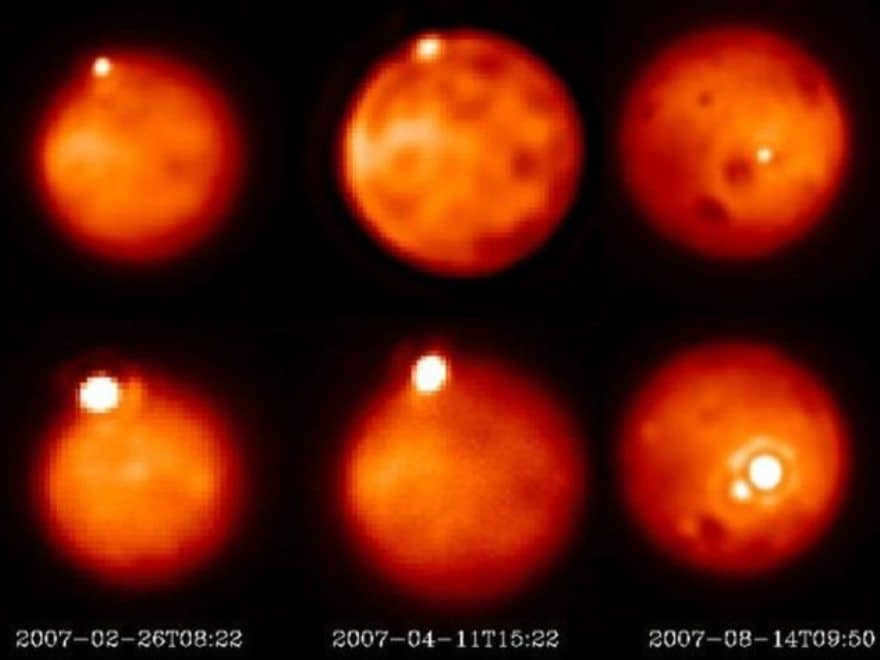
Io is known for its heightened volcanic activity. Consider the instances of St. Helens’ eruption in 1980 in Washington, Mount Vesuvius’ eruption in 70 AD, which led to the burying of Pompeii in ash, or the Yellowstone supervolcano (situated beneath the state of Wyoming). However, all of these incidents appear insignificant compared to Io’s volcanic activity. It appears that this small satellite houses hundreds of volcanoes.
The eruptions are so intense that they can be observed from telescopes on Earth. The explosions cover hundreds of square miles within a second, and individual eruptions unleash 20 trillion watts of energy, scattering substantial amounts of debris across the surface. Occasionally, clouds of sulfur, rocks, and debris can ascend to heights of 400 kilometers. Consequently, lava rivers may form.
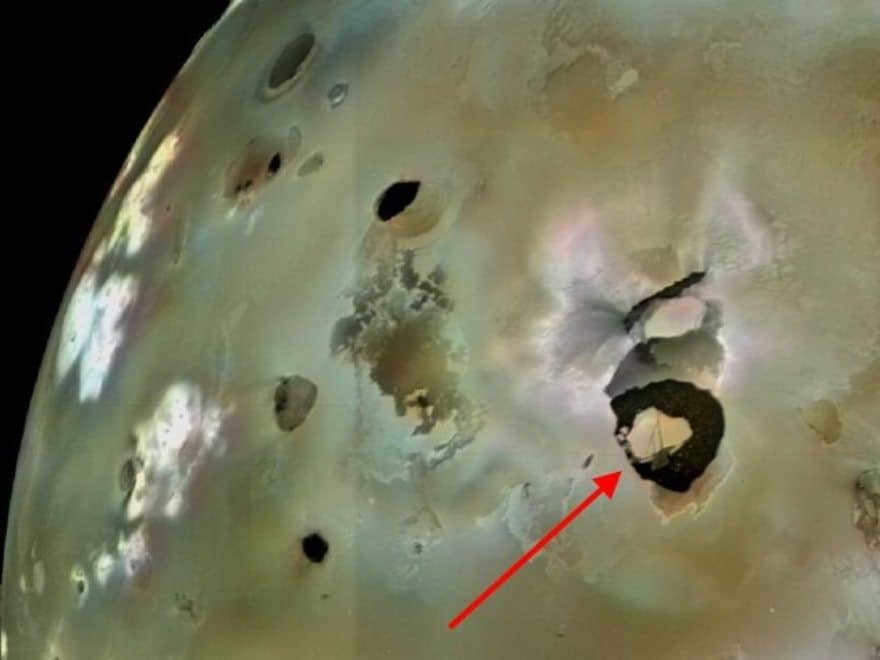
Delve beneath the surface and discover yourself amidst oceans of molten rock. The churning subsurface movements provide the energy for powerful volcanic eruptions. The subterranean reservoir spans a thickness of 50 kilometers, which accounts for why we witness the most intense volcanic activity in this region.
Scientists have computed that Io boasts a diameter similar to the width of North America, yet the moon emits lava at a rate a hundred times greater than all the volcanoes on Earth combined. At Patera Loki, a solitary volcanic depression spans 204 kilometers and is continually replenished by magma rising from below. This sea of molten rock is estimated to be millions of times larger than any found on our planet.
The temperature of the satellite
One important aspect to consider when it comes to satellites is their temperature. The temperature of a satellite is a critical factor that can affect its performance and overall functionality. It is crucial to maintain the satellite at an optimal temperature to ensure its proper operation.
Various factors can influence the temperature of a satellite, including its position in orbit, exposure to sunlight, and the materials used in its construction. Satellites that are exposed to direct sunlight can experience significant temperature fluctuations, with some parts reaching extremely high temperatures while others remain relatively cool.
To regulate the temperature of a satellite, various thermal control mechanisms are employed. These mechanisms can include thermal blankets, radiators, and heat pipes. Thermal blankets are used to insulate the satellite and protect it from extreme temperature variations. Radiators help dissipate excess heat generated by the satellite’s electronic components, while heat pipes transfer heat from one area to another.
Monitoring and controlling the temperature of a satellite is a complex task that requires constant attention. Engineers and technicians closely monitor the temperature of the satellite using sensors and telemetry data. If the temperature exceeds safe limits, corrective measures can be taken to prevent any damage to the satellite and ensure its continued operation.
Overall, understanding and managing the temperature of a satellite is crucial for its successful operation. By carefully monitoring and controlling the temperature, satellite operators can maximize performance and prolong the lifespan of the satellite.
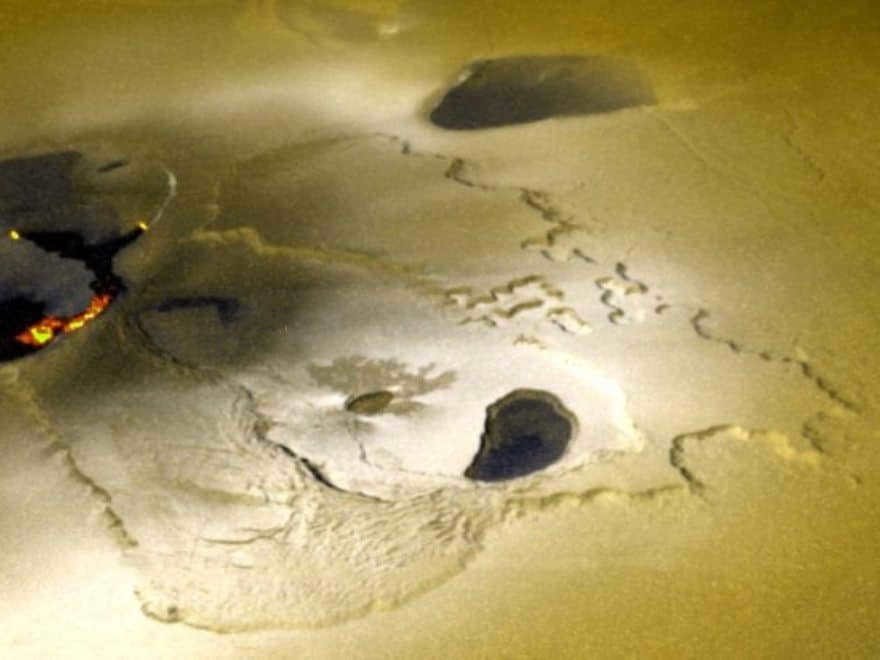
The temperature on Io is highly variable and not consistent. In fact, there are significant fluctuations in temperature across the surface. Certain regions with volcanic activity can reach temperatures as high as 1700°C (hotter than Mercury).
It may seem like you would instantly burn up, but it’s not that straightforward. The truth is that away from volcanic areas, temperatures can drop to -153°C. NASA’s Galileo spacecraft discovered that Io’s nighttime temperatures near the equator are similar to those at the poles. This is the opposite of what we observe on Earth, where the equator receives more heat than the poles.
Make sure to bring an air freshener
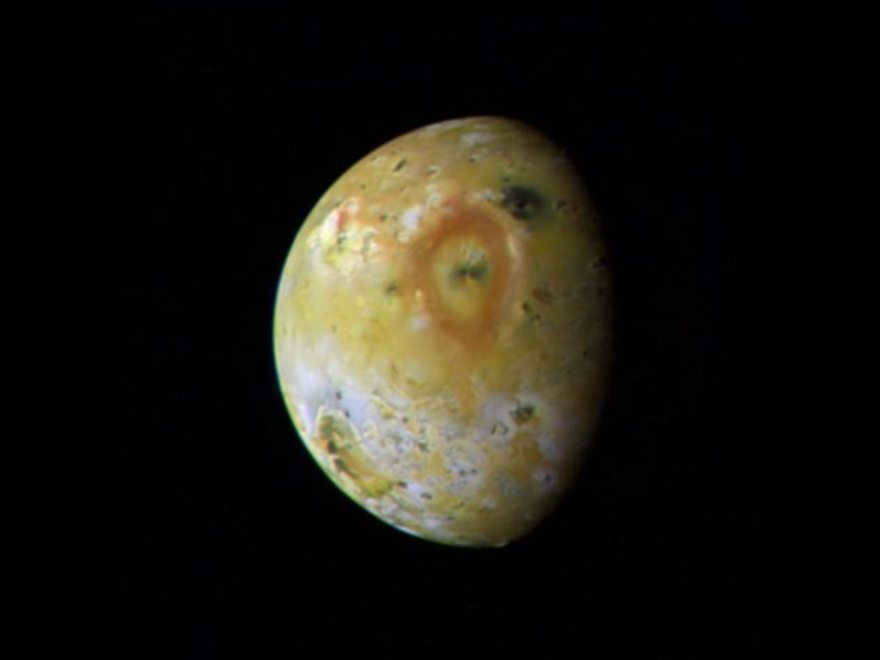
Io appears to be the most odorous place in our solar system. Not only will you find yourself in an infernal environment devoid of any water, but it also emits a foul smell reminiscent of rotten eggs. Why is that? Well, the thin layer of atmosphere consists mainly of sulfur dioxide, a byproduct of volcanic activity, and other elements that keep the gas suspended in the air.
It’s worth noting that the continuous volcanic eruptions on Io constantly replenish the gas reserves, resulting in the emission of an unpleasant odor throughout the entire moon. However, unlike many other celestial bodies in our system, Io still retains an atmosphere (albeit a pungent one). So, would you rather face a deadly vacuum of space or endure the stench of Io’s atmosphere? Either way, suffocation is inevitable.
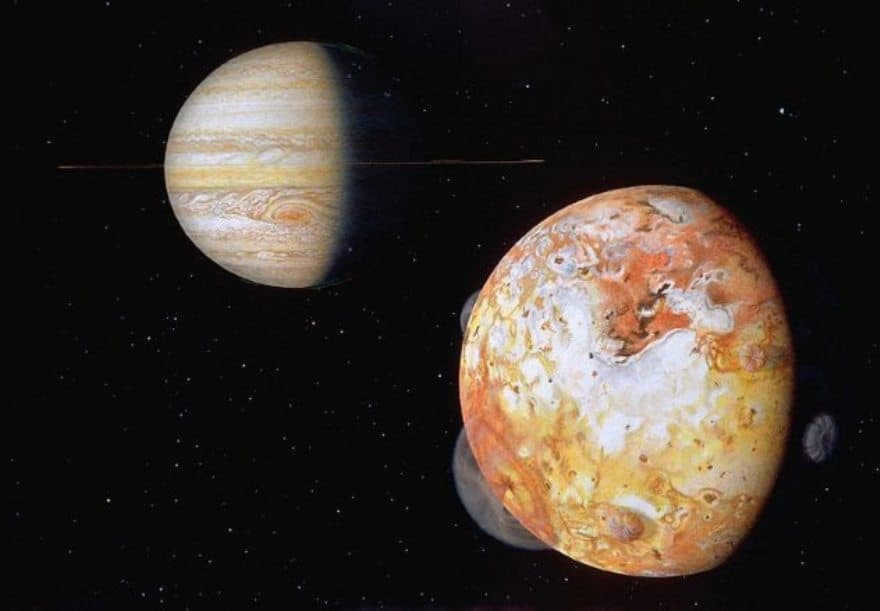
Io is an incredibly ionized object due to the presence of sulfur dioxide. As it orbits around Jupiter, the moon encounters powerful magnetic fields, effectively transforming into an electric generator. Astonishingly, the planet’s magnetic forces cause Io to shed around a ton of its surface material every second!
The discarded material rapidly becomes ionized, giving rise to a dense cloud of radiation enveloping Io – a plasma torus. This is one of the few locations in the system where such a phenomenon has been observed. Unfortunately, the abundance of radiation makes it highly unlikely for life to emerge, though the possibility cannot be entirely dismissed.
A brief year
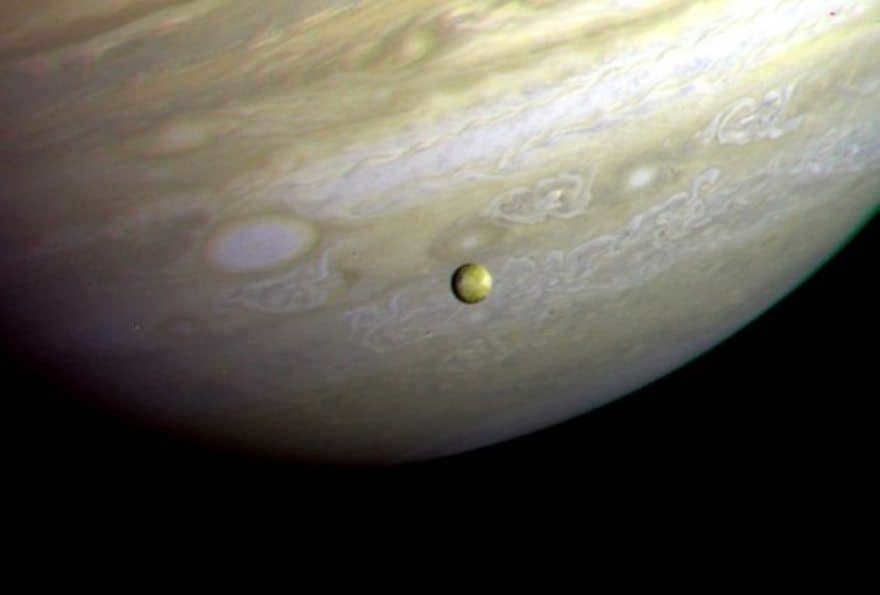
The satellite Io has the shortest year among the objects in our solar system. It completes one orbit around its planet in just 42 hours. In comparison, Earth’s Moon takes 27 days to complete one orbit around our planet. What’s interesting is that Io’s year is almost the same length as its day, which is 1.8 days.
Modified form
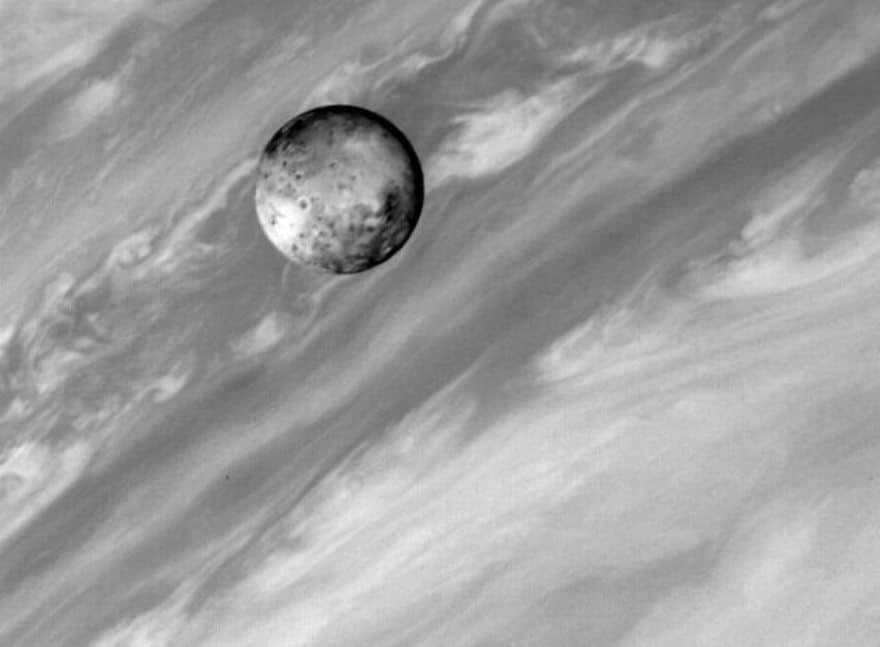
Io finds itself in a challenging predicament as a result of the immense gravitational force exerted by Jupiter. The immense planet’s gravitational pull deforms the satellite, akin to stretching and compressing dough, resulting in a change in its shape (the molten rock inside behaves like gelatin). This tidal heating effect causes the lunar surface to rise and fall by hundreds of feet on a daily basis.
Europa and Enceladus, Jupiter’s other satellites, experience a comparable scenario. However, their surfaces display extensive ice fractures and erupting geysers.
Snow made of sulfur
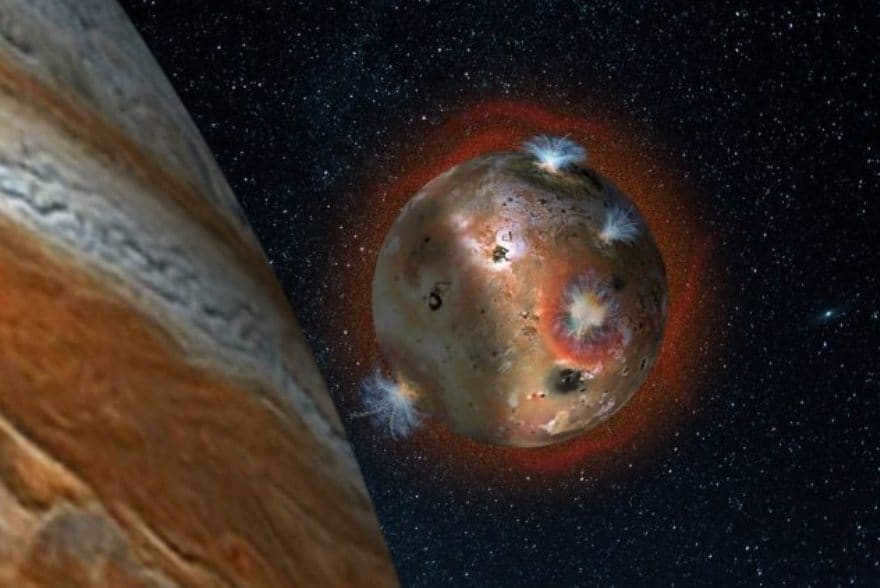
Every day, it is possible to witness the mesmerizing phenomenon of sulfur snow on Io. For a brief period of two hours each year, the moon finds itself engulfed in the colossal shadow cast by the planet. This creates a barrier that obstructs the sun’s rays from reaching Io, depriving it of its fair share of warmth. Consequently, the temperature plummets, causing sulfur dioxide to descend upon the surface in the form of delicate sulfur snowflakes. Additionally, the gases emitted by the volcanoes freeze during this time.
Furthermore, these shadowy interludes appear to cause a collapse in Io’s lunar atmosphere. However, with the emergence of the first rays of sunlight, the atmospheric layer is revitalized as the fallen snow undergoes a transformation into gas through the process of sublimation. Hence, Io’s atmosphere perpetually experiences a continuous cycle of collapse and rebirth.
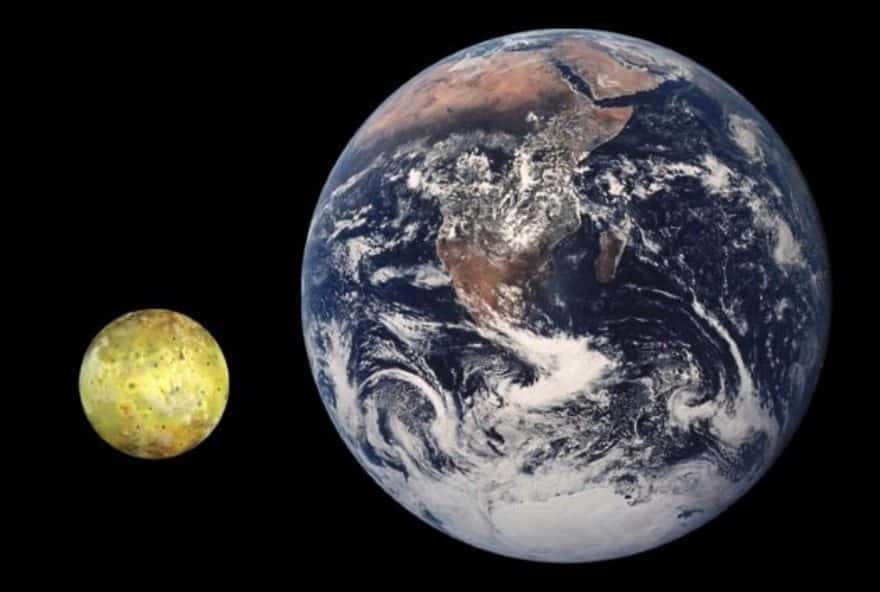
We are currently facing one of the most peculiar objects in our solar system: massive volcanoes, vast oceans of molten lava, a noxious atmosphere, and even being bombarded by radiation from a gas giant. However, what researchers find most intriguing about this object is not its geophysical anomalies, but rather the unique opportunity it presents to trace the history of Earth’s own formation.
Our planet came into existence over 4 billion years ago, initially as a colossal mass of molten rock that was continually bombarded by asteroids, which perished in the oceans of lava. Remarkably, the current state of Io allows us to catch a glimpse of what our own planet may have looked like in its early stages of development.
Io is, in fact, the most active volcanic moon in the entire solar system and orbits around the gas giant Jupiter.
As we delve further into the system, we continue to unveil more and more enigmas. The Galilean moons, the four largest satellites of Jupiter, have emerged as particularly fascinating. Among them, Io stands out due to its remarkable volcanic activity, boasting over 400 active volcanoes.
The Unveiling and Naming
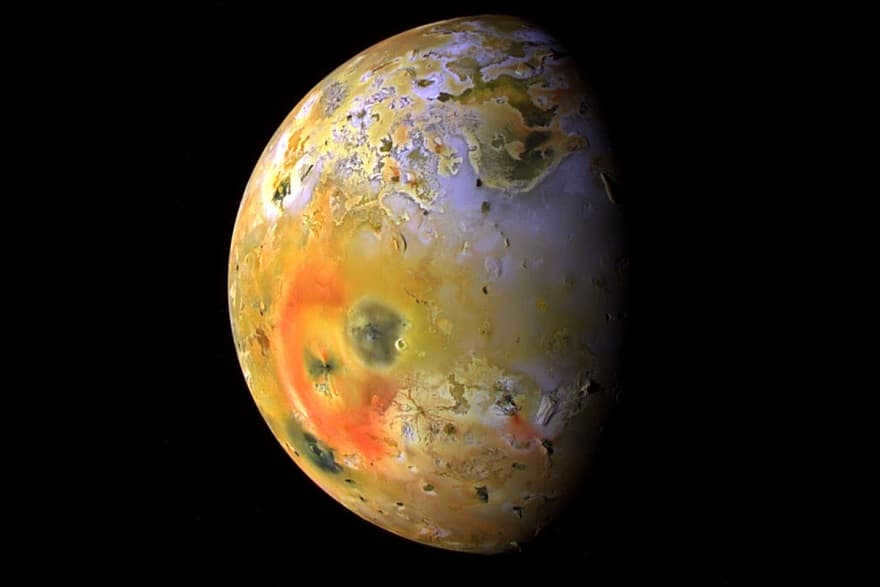
In 1610, the innovative telescope created by Galileo Galilei allowed him to observe a celestial body that he initially believed to be a single point of light. However, upon further observation the following day, he was able to discern that it was actually two separate bodies.

Simon Marius purportedly observed the satellites in 1614. Curiously, his monikers were subsequently chosen as the official labels, as they had previously been listed solely in Roman numerals.


Galileo’s telescope with a handwritten note indicating the lens’s magnifying power
Io was Zeus’ lover. She hailed from a lineage of Heracles’ descendants and served as a priestess at Hera’s temple. All of her geographical features were named after deities associated with fire and thunder, as well as characters and locations from Dante’s writings.
There are currently 225 volcanoes, plateaus, mountains, and major albedos documented in the IAU. One can find Prometheus, Twashtar Patera, or Pan Mensa among them.
Measuring 1821.6 km in radius and weighing – 8.93 x 10 22 kg, this celestial body is only about 0.266 times the size of Earth and 0.015 times its mass. It orbits at an average distance of 421700 km from the planet, but due to its eccentricity of 0.0041, it is able to come as close as 420000 km and move as far as 432400 km away.

Here we have a comparison of the sizes of various satellites and planets within our solar system.
Io, one of the satellites, is the closest to Jupiter among the Galileo group. It is positioned between Thebes and Europa and is constantly affected by Jupiter’s tidal forces, causing it to always face the planet on one side. One of the most intriguing features of Io is its active volcanoes, which are still not fully understood by scientists.
A skilled tarot reader can provide insights into your future, your relationships, and help guide you towards making the right decisions.

Now you know the identity of the celestial body Io orbits around.
The primary characteristics of Io, the satellite
Io’s orbital period is 42.5 hours, and it has a resonance ratio of 2:1 with Europa and 4:1 with Ganymede. These factors contribute to its eccentricity, which serves as the primary cause for its heating and geological phenomena.
Composition and surface
Io is unique among moons in the solar system due to its high density of 3.528 g/cm 3. The moon is primarily composed of a combination of silicate rock and iron, giving it a composition similar to that of Earth-type planets. The crust and mantle of Io are rich in silicates, while the core is primarily made up of iron and iron sulfide. The iron sulfide layer makes up approximately 20% of Io’s total mass and has a radius of 350-650 km. However, if sulfur is added to the core, the radius of the iron sulfide layer can increase to 550-900 km.
The mantle of Io contains 75% magnesium and high levels of iron. The lithosphere, which consists of basalt and sulfur, covers a depth of 12-40 km.
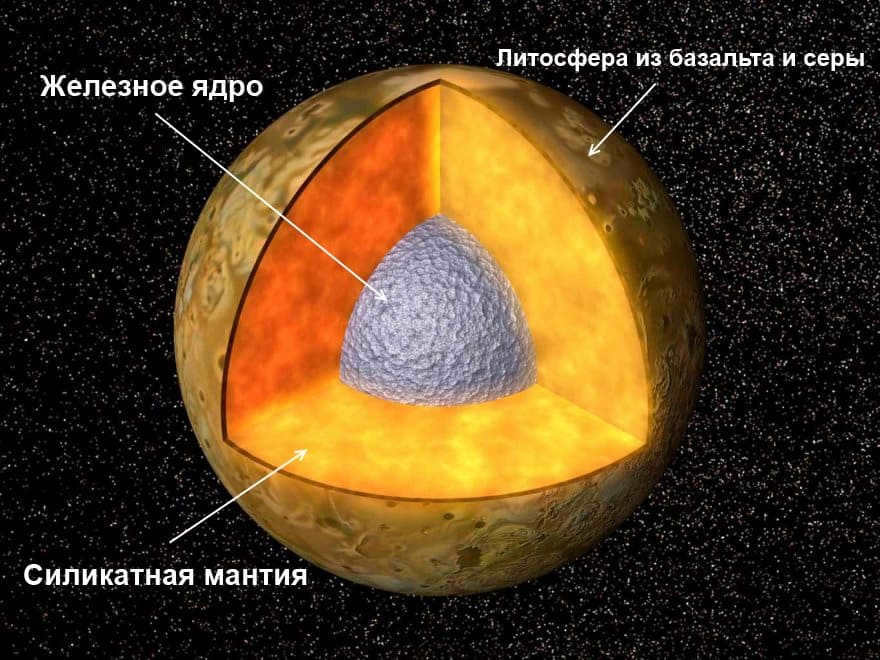
An examination of the magnetic and heat flows has revealed that the magma ocean can be found approximately 50 kilometers beneath the surface of Io. This ocean occupies a thickness equal to 10% of the mantle and is accompanied by temperatures reaching up to 1200°C.
The primary source of this intense heating is the tidal flexing caused by the orbital resonance between Europa, Ganymede, and Io. The amount of heating experienced by Io is also influenced by its distance from Jupiter, its eccentricity, its composition, and its physical state.
A skilled tarot reader is able to provide answers to the following questions:
What does the future hold for you? How will your relationships develop? Which decision should you make?

The gravitational pull creates resistance, resulting in an increase in temperature on the moon Io. This leads to frequent volcanic activity and the expulsion of lava reaching heights of up to 500 kilometers. The outer layer of the moon’s surface is largely free from impact craters and is instead characterized by plains, mountains, pits, and volcanic flows, which contribute to its bright appearance.
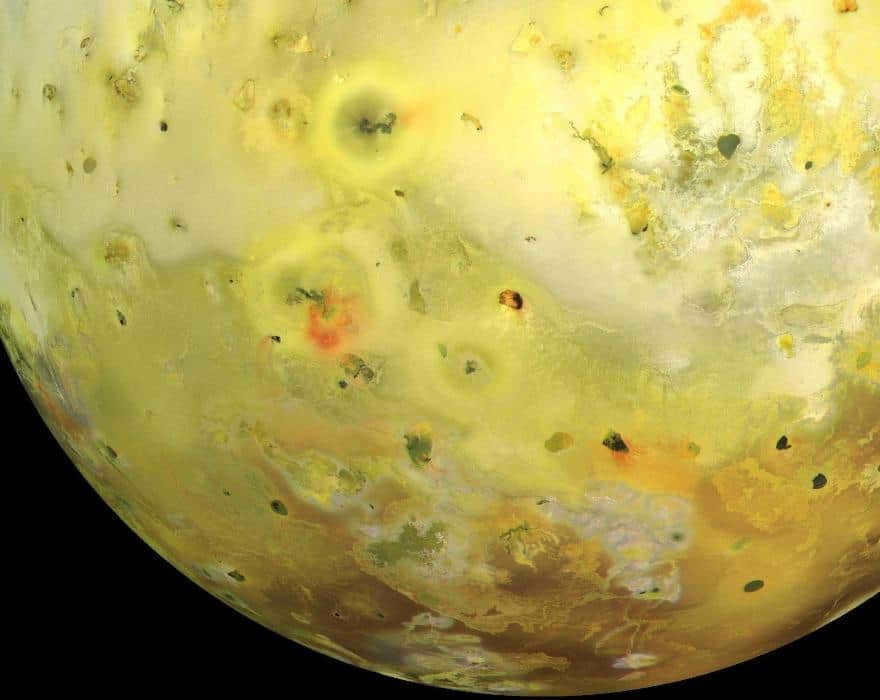

The eruption in 1997 resulted in the formation of a dark spot that was captured by the Galileo spacecraft.
On the moon’s surface, there are large former and gray areas due to the presence of sulfur dioxide. Yellow and yellow-green areas are formed by atomic sulfur, while radiation causes the polar areas to turn red.
Although water is scarce on the moon, there are still ice deposits in certain regions. The mountains have an average height of 6 km, reaching a maximum of 17.5 km on the southern side. These mountains are isolated and do not exhibit any visible global tectonic patterns.
The majority of the mountains are formed by compressions in the lithosphere, driven by deep shears.
Volcanic Activity
Right in front of you lies the very first volcanically active entity within the system. Its surface is adorned with an array of hundreds of volcanoes and lava streams. This not only gives rise to lava emissions that reach an astounding height of 500 km, but it also exerts a significant influence on the geology.
As a result of large-scale eruptions, immense flows spanning hundreds of kilometers are formed, composed of basaltic silicates, iron, and magnesium. In addition, sulfur, sulfur dioxide, and ash are released into space.
The volcanic activity is also responsible for the creation of numerous depressions that extend over a distance of 41 kilometers or more.
Atmosphere
The atmosphere of the satellite is composed of various elements including sulfur dioxide, sulfur monoxide, atomic sulfur, sodium chloride, and oxygen. The pressure in the atmosphere ranges from 3.3 x 10 -5 to 3 x 10 -4 Pa and can drop to 0.1 x 10 -7 Pa on the night side.
The temperature on the satellite also varies, ranging from -163.15°C to -183.15°C, with occasional peaks reaching as high as 1526.85°C. The atmospheric density is highest in volcanic ridges, which leads to replenishment of the atmosphere. Volcanic eruptions release significant amounts of sulfur dioxide, with approximately 104 kg being released per second. However, most of this sulfur dioxide condenses to the surface.
The presence of elements such as sodium chloride, sulfur monoxide, atomic sulfur, and oxygen in the atmosphere can be attributed to volcanic degassing. The satellite’s auroras are formed when charged particles from Jupiter’s magnetosphere interact with the satellite’s atmosphere. The most intense auroras are typically observed near the equatorial line.
Interaction with Jupiter’s magnetosphere
Io plays a crucial role in the formation of Jupiter’s planetary magnetosphere. The moon’s gravitational pull causes Jupiter to extract material from Io’s atmosphere at a rate of one ton per second. This material mostly accumulates in orbit around the planet, creating a neutral cloud that contains elements such as oxygen, sulfur, sodium, and potassium.
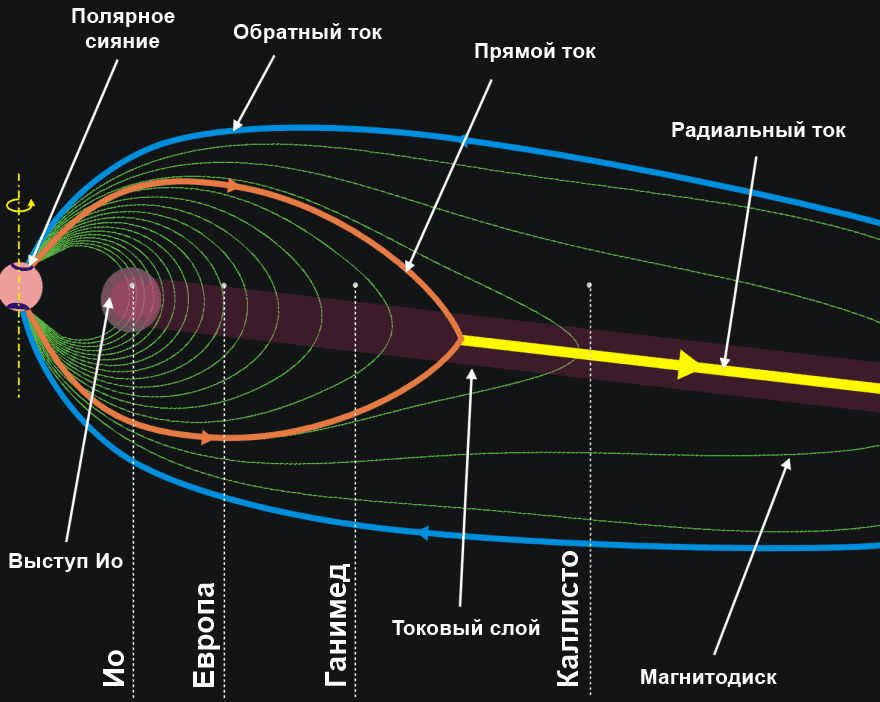
The magnetic field of Jupiter’s currents combined with Io’s plasma torus
The interaction of planetary magnetic field lines with the moon brings together Io’s atmosphere and neutral cloud with Jupiter’s polar atmospheric layer. As a result, a current is generated, which is responsible for the creation of auroras.
A knowledgeable tarot reader will address the following inquiries:
What lies in store for you in the future? How will your relationships unfold? What is the right decision to make?

Lines that intersect the lunar ionosphere also create an electric current that can produce a maximum of 400,000 volts. The current produces a magnetic field as a result. Similar phenomena have been observed in other moons of Jupiter.
The examination
Pioneer-10 (1973) and Pioneer-11 (1974) made their inaugural encounters with the satellite. These expeditions afforded the initial evaluation of Io’s magnitude, makeup, substantial density, existence of an atmosphere, and formidable radiation belts.
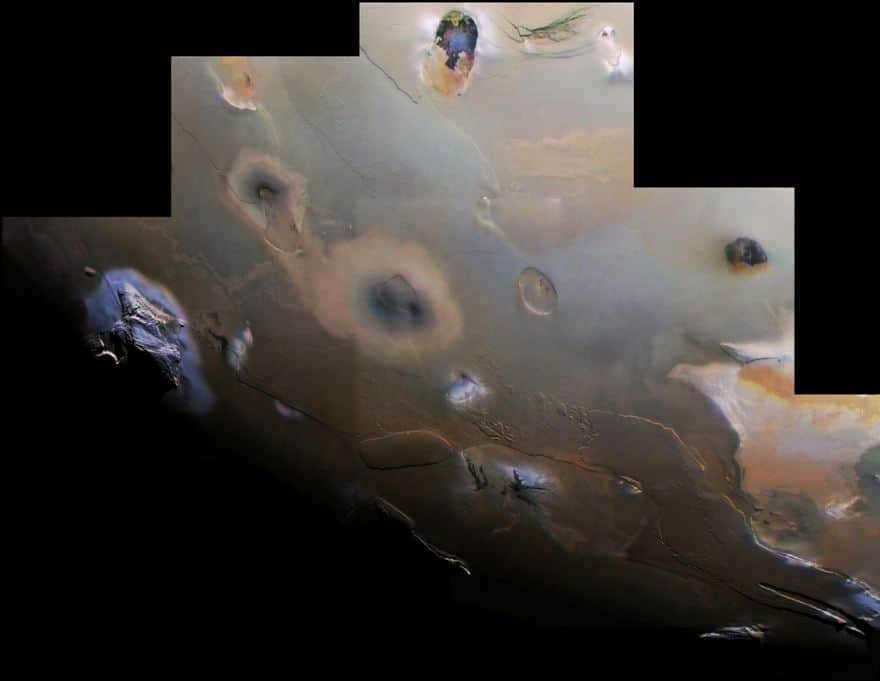
Io’s south polar region was captured in the Voyager-1 mosaic.
In 1979, the Voyager 1 and 2 spacecrafts conducted flybys, enabling the capture of improved images. These images revealed the colorful landscape of Io for the first time. The data also indicated the presence of abundant sulfur on the surface and the presence of active volcanoes.
In 1995, the Galileo spacecraft reached Jupiter and made a close approach on December 7. During its mission, Galileo closely observed volcanic eruptions, analyzed the composition of Io, and documented surface changes that occurred since the Voyager spacecrafts’ visit.
The Galileo mission was extended twice, in 1997 and 2000. Throughout this time, Galileo conducted six flybys of Io, providing valuable insights into its geological processes and ruling out the presence of a magnetic field.
Back in 2007, the New Horizons spacecraft made a remarkable flyby of the system, capturing numerous images of the surface, plumes, and previously unknown sources of jets.
Fast forward to 2011, the Juno spacecraft embarked on its mission and is currently diligently observing the planet and its satellites. Thanks to the cutting-edge technology of an infrared spectrometer, scientists are now able to monitor volcanic activity.
Looking ahead to 2022, there are plans to launch the JUICE mission, which will provide a unique opportunity to study volcanoes for a span of 2 years, as it orbits Ganymede.
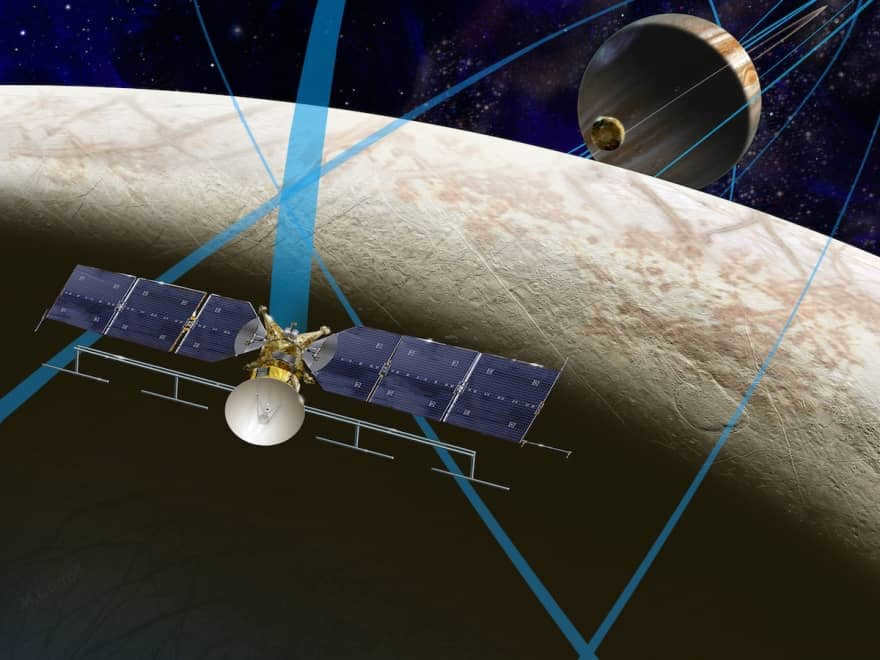
The IVO mission, which was planned to be launched in 2021, was not approved. Io is known as one of the most fascinating moons in the solar system and is also the densest. Despite the presence of numerous volcanoes, certain areas of Io experience extremely low temperatures and are filled with electrical activity. In the future, it may be possible to harness the induced magnetic field of Io for our own purposes. However, the presence of volcanoes makes it challenging for colonists to approach the moon. The map below provides an overview of Io, which is one of Jupiter’s satellites.
In conclusion, you have now learned that Io is a satellite of the planet Jupiter.
Map of the surface
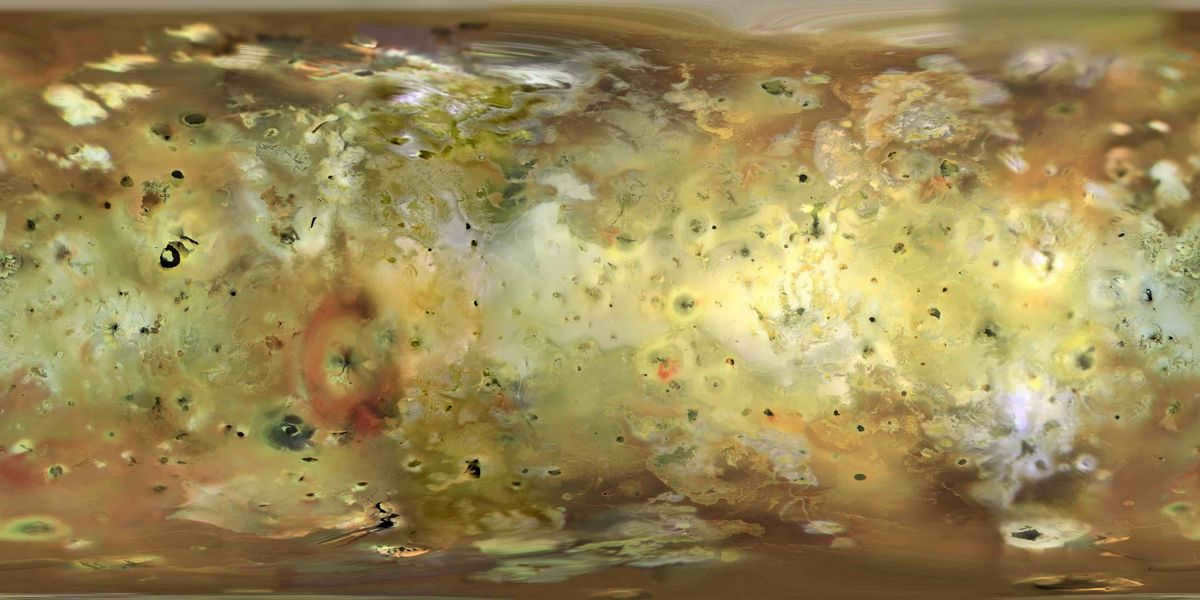
To view a larger version of the image, simply click on it
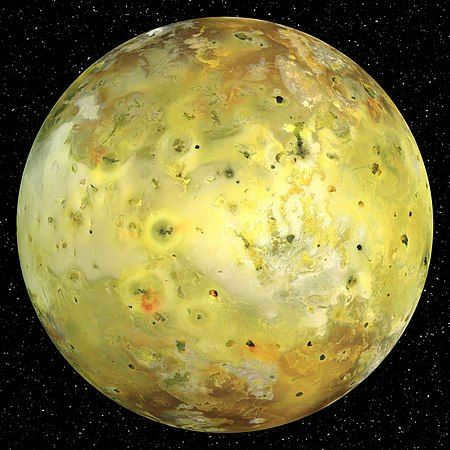
Io (Greek Ἰώ ) is a moon of Jupiter, the nearest of the four Galilean moons to the planet. It takes its name from the mythological Io, a priestess of Hera and the lover of Zeus. With a diameter of 3642 kilometers, it is the fourth largest moon in the entire solar system. Io is also the most geologically active object in the solar system, boasting over 400 active volcanoes. Several of these volcanoes emit sulfur and sulfur dioxide so forcefully that their plumes reach heights of 500 kilometers.
Unlike the majority of satellites in the outer regions of the solar system (which are primarily composed of water ice), Io is predominantly comprised of silicate rocks that encase a core of molten iron or iron sulfide. The presence of volcanic activity on Io’s surface grants it a set of distinct characteristics. The majority of Io’s surface consists of plains that are covered in gray or frozen sulfur dioxide. The surface is constantly altered by volcanic ash and lava flows, leading to a range of colors such as yellow, white, red, black, and green (mostly influenced by various allotropes and sulfur compounds). The emissions from volcanoes also contribute to the creation of Io’s thin and uneven atmosphere, as well as the plasma flows within Jupiter’s magnetosphere, which includes a massive plasma torus that surrounds Io.
Io in definitions and brief citations [ edit ]
The impact of Io’s presence on the activities occurring within Jupiter’s magnetosphere is particularly remarkable in its unexpectedness. [1]
Currently, there is no other celestial body within the solar system that exhibits such intense subsurface activity as Io. [2]
The rate at which volcanic particles are ejected from Io’s fiery mountains reaches speeds of up to one kilometer per second. [2]
The question of what substances are expelled by Io’s volcanoes was confidently answered by the Voyager 1 instruments, which identified sulfur dioxide as the primary gas. [2]
Additionally, sulfur monoxide is the second most prevalent gas observed in Io’s atmosphere, a moon of Jupiter. [3]
Galileo suggested a solution to a significant practical issue by utilizing the satellites he discovered around Jupiter, namely Io, Europa, Ganymede, and Callisto. The proposed solution involved determining the geographic longitude of an observation site. [4]
In a more recent development, the satellite Io emitted an astonishing energy of 6 million amperes, with the current of this energy being directed precisely at the center of Jupiter. [5]
There was no limit to the contentment of Huygens’ contemporaries. Undoubtedly, everything is impeccably arranged in the heavens: there are six planets (only Mercury, Venus, Earth, Mars, Jupiter, and Saturn were known) and satellites – the same quantity (the Moon, Io, Europa, Ganymede, Callisto, and the “newcomer”). Alongside the Sun, around which the entire system dutifully revolves, it remarkably coincides with the Bible: depending on whether you prefer the Old Testament or the New Testament, you will perceive the embodiment of either the prophet Jacob with his twelve sons or Jesus with his twelve apostles.
It is uncertain whether Huygens himself perceived it as a divine predestination or simply a law of nature, but he alone ceased further exploration for new satellites and in 1659 announced that no additional celestial bodies within the solar system will ever be discovered. [6] :151
However, similar to the description in Dante’s Inferno, Io boasts a plentiful supply of sulfur, which serves various purposes on the moon. B. Smith’s analysis revealed that sulfur and its dioxide on Io are primarily in solid form from the surface to a depth of approximately 1 km. As the depth increases, the dioxide undergoes a phase transition and becomes a liquid, while the solid sulfur remains unchanged. At around two kilometers deep, the sulfur also transitions into a liquid state.
This phenomenon could potentially explain the presence of escarpments on Io. The edges of these cliffs are the areas where pressurized substances are most likely to escape. If we imagine an artesian well filled with sulfur and sulfur dioxide instead of water, they would eagerly seek out any cracks or crevices to emerge into the open. Thus, the frozen streams of sulfur from Io’s depths could easily create ledges along the escarpments. But what exactly are these streams? Once released from the pressure of the moon’s upper crust, the mixture of sulfur and gases vigorously boils and bubbles. This process is akin to the expansion of “Satan’s champagne,” where each unit of liquid vaporizes into a volume five thousand times greater than its original size. Interestingly, liquid sulfur is lighter than solid sulfur, causing the sulfur “ice floe” to quickly sink beneath the molten surface. If the gases and crystallizing sulfur come into contact during this phase, the mixture of solids and liquids will continue to expand until its internal pressure matches the external pressure. Since the atmospheric pressure on Io is quite low (approximately 10 – 7 bar), the velocity of the gas outflows from the moon’s interior must be quite impressive, reaching speeds of 350 m/s. It is possible that snow-like sulfur deposits act as plugs, preventing sulfur from reaching the surface. These deposits are not made of water, but rather sulfur, which is an essential component of Io’s geology. [2]
There was a lot of curiosity about what exactly Io’s volcanoes eject. According to the instruments on Voyager 1, they mainly emit sulfur dioxide. However, it is rather suspicious that there is no sign of water being released. This is surprising because on Earth, volcanoes release so much water that it is believed to be the source of most of our seas and oceans. Could it be possible that Io has been expelling water for such a long time that its reserves have been completely depleted? [2]
A profound sulfur fountain has the ability to expel a layer of snow, obstructing its path for approximately 70 kilometers. Additionally, the adjacent tens of kilometers should be completely blanketed with this peculiar “snow” as observed by us. It is important to note that these are not mere conjectures; the “Voyager” images distinctively display escarpments, as well as accompanying streams of various shapes and forms, and regions covered with layers of “sulfuric acid” snow. [2]
And the low atmospheric pressure on Io (about 10 ~2 Pa) creates the perfect conditions for a unique phenomenon – the eruption of gas at an astonishing speed of 350 m/s.
In this extraordinary world, the role of the cork can be played by none other than snow. However, not the usual “ash-two-oh” (H2O) snow, but “es-two-o” (S2O) snow, without sulphur, of course. Sulfur is a vital component of this world, and without it, nothing can exist. So, imagine a deep sulfur fountain erupting from a crevasse, forcefully pushing out a thick layer of snow, blocking its path for over 70 kilometers. The surrounding area for tens of kilometers would be covered in this peculiar “snow” that is unlike anything we’ve seen before. This is not mere speculation – the images captured by the “Voyager” spacecraft clearly show escarpments, bright and dark streams, and areas covered in layers of “sulfuric acid” snow. [2]
Sulfur monoxide, which is the second most abundant gas detected in Io’s atmosphere (a moon of Jupiter), has been observed through ground-based millimeter-wave measurements. The SO/SO2 ratio is estimated to be between 3-10% by volume. This observed abundance is believed to be the result of SO formation through the photolysis of SO2. Additionally, the low atmospheric pressure (~10 -9 bar) and the irregular distribution of SO2 are attributed, at least in part, to volcanic outgassing. Gaseous SO2 has been detected in smoke plumes during volcanic eruptions and in regions with volcanic activity. In this study, we demonstrate that high-temperature volcanic gases released from magma can account for the observed levels of SO in Io’s atmosphere. [3]
The volcanic gases’ total pressure and bulk elemental composition were used as input data for our modeling. While we do not know the initial pressure at which volcanic gases are released into Io’s atmosphere, it is likely that pressures up to ~100 bar in volcanic channels on Io, depending on the depth of the volcanic source region. It should be noted that the Voyager observations show pressures of ~10 -7 bar in the observed plume, but our focus was on modeling the chemical interaction of volcanic gases within the volcanic channels, not in the plumes. For our modeling, we assumed approximate pressures ranging from 10 -8 to 100 bar, and intermediate pressures within this range resulted in the observed SO/SO ratios2 at the observed hot spot temperatures. [3]
By comparing the eruption time (crustal breakthrough) with the chemical lifetime for volcanic gases, we have determined that thermochemical equilibrium is achieved in volcanic gas eruptions. Thermochemical equilibrium is reached rapidly in the source region where temperatures and pressures are higher. However, in plumes where temperatures and pressures are lower, chemical compounds decay and thermochemical equilibrium is not reached. In an intermediate level near the volcanic vent, there is dynamic stability and thermochemical equilibrium is achieved in volcanic gases released from magma.
As the volcanic gases cool, the content of SO gradually decreases due to direct thermochemical reactions. These reactions typically involve the conversion of SO to other sulfur gases, such as 2SO2 and S2. [3]
It is a fact that Jupiter’s moon Io contains significant amounts of sodium, magnesium, and iron sulfates. These sulfates are formed through the fascinating phenomenon of “sulfur” volcanism, where sulfur and its oxides are expelled from the depths of Io’s atmosphere-deprived surface, reaching heights of up to 300 km. It is possible that water vapor and chlorine act as oxidizers for sulfur in this unique process. Currently, Io is covered approximately 70% with sulfur and 30% with sulfates. There are no other moons in the solar system that resemble Io, and it is distinct from Mars. [7]
Me in the world of advertising and factual writing [ edit ]
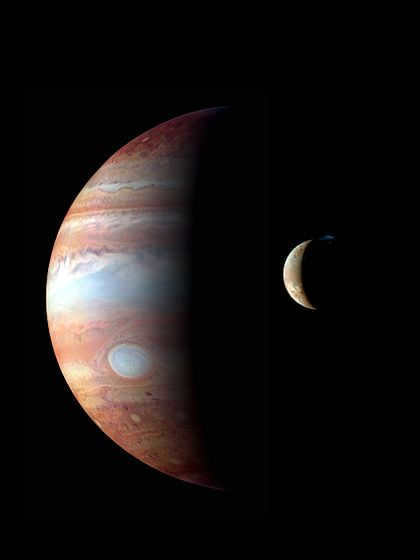
In early March 1979, while receiving data from Voyager 1 near Jupiter, L. Morabito, a staff member at the U.S. National Aeronautics and Space Administration, observed the boundary (the visible edge of the disk) of Jupiter’s moon Io in a satellite image. The photo intentionally had excessive exposure to enhance the clarity of the boundary. A peculiar, mushroom-shaped object extended beyond the boundary. The height of the object was nearly three hundred kilometers above the moon’s surface. An urgent conclave of planetologists and image processing experts concluded that a massive column of smoke, gases, and other volcanic materials had erupted over Io’s surface. [2]
In 1974, V. V. Prokofieva, an employee of the Crimean Astrophysical Observatory of the USSR Academy of Sciences, made an interesting observation about Io. He noticed that there were times when Io appeared brighter than usual. Shortly after, at the Shemakha Observatory in Azerbaijan, spectrograms of Io revealed emission lines of sodium, magnesium, iron, and calcium. The question arose: where did these substances come from? Could they have been expelled from Io’s volcanoes along with the gases and vapors? However, this conclusion was impossible to prove at that time. Nowadays, thanks to space images, we can clearly see at least three columns of volcanic smoke and ash on Io. There are four more columns that have been detected with varying degrees of certainty. The height of these columns indicates that the volcanic particles ejected by Io’s fire-breathing mountains reach a speed of one kilometer per second! On Earth, during the strongest eruptions like those of Mount Etna, the speed is only about fifty meters per second. Furthermore, there is currently no other celestial body in the solar system that exhibits such intense interior activity as Io. [2]
For the first time, a powerful magnetosphere on Jupiter was detected using terrestrial radio astronomy methods. This significant finding occurred shortly after the discovery of synchrotron radio emission from Jupiter in the centimeter wavelength range. Even prior to this, there were observations of immense power bursts of Jupiter’s long-wave radio emission, which coincided with the orbital position of its remarkable satellite, Io, which is in close proximity to the planet’s surface. These bursts are undeniably linked to active processes occurring in Jupiter’s magnetosphere. Particularly surprising is the unexpected influence of the satellite Io on the dynamics of the processes within Jupiter’s magnetosphere. [1]
The Galileo spacecraft, which is currently in orbit around Jupiter, made an interesting discovery at its moon Io – a massive iron core. This discovery was made by analyzing the signals sent by the spacecraft to Earth while it was flying close to Io, approximately 900 kilometers away. The presence of this core allowed scientists to calculate the mass of Io. The core itself is made up of iron and iron sulfide and measures around 900 kilometers in diameter. Surrounding the core is a liquid mantle of molten rock, followed by a solid surface. John Anderson, a prominent member of the Galileo project, believes that the structure of Io is a result of the strong gravitational pull exerted by Jupiter. This intense gravitational force causes the satellite to become compressed and leads to the volcanic activity observed on Io. Additionally, it is possible that tidal influences have also contributed to the development of a magnetic field on the moon. [8]
It is worth noting that Galileo proposed a unique solution to the practical problem of determining geographic longitude by utilizing the satellites of Jupiter that he discovered (Io, Europa, Ganymede, and Callisto). This method, which relied on the difference in local time between two points, is now only of historical significance. [4]
In the latter half of the 20th century, astronomers had the opportunity to closely observe the Galilean satellites of Jupiter thanks to the flights of automated interplanetary stations. This led to the discovery of their extraordinary landscapes and significant findings, such as the presence of volcanoes on Io and a vast ocean of liquid water beneath Europa’s icy surface. [4]
Recently, Jupiter’s moon Io released a staggering amount of energy – 6 million amperes, to be exact. This immense current was aimed directly at Jupiter’s core. Witnesses report that the space between Io and Jupiter is now starting to emit a radiant glow. Interestingly, another one of Jupiter’s satellites, Europa, seems to possess its own atmosphere, making it a potentially habitable celestial body. In my opinion, sending manned missions to Mars will bring significant benefits to humanity. [5]
Io in literature and writing [ edit ]
If I were unable to produce any worthwhile written work, I believe I would enjoy being the proprietor of my very own hardware store. I have always been captivated by the extensive assortment of tools utilized to uphold our civilization, as well as the various fasteners, connectors, and mechanisms that hold everything in place. And let’s not forget about the substances such as putty, plaster, cement, and paint that give it the appearance reminiscent of the landscapes found on Io.
My involvement in poetry [ edit ]
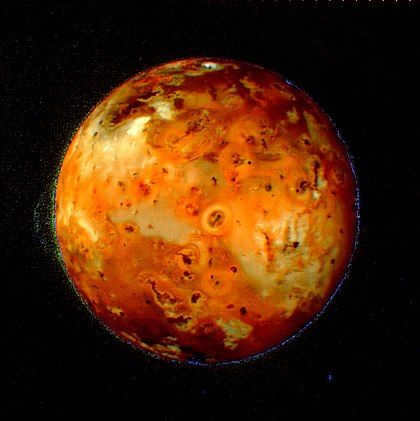
As the moon rises above the sea,
Prior to the bound Titan,
In ceaseless striving,
The two-horned Io,
No longer tormented by a gadfly,
but chastised by love,
She passes by in agony.
Immovably crucified,
He gazes at her. [9] <. >
By the moon over the ocean,
Prior to the tortured Titan,
In the meandering of the wandering,
Io runs, radiantly,
No longer tormented by a gadfly,
"Io is compelled by love.
The crucified man, unmovable.
Watches her. [10]
- ↑ 12By I. Shklovsky, the book “Mind, Life, Universe” was published by “Janus” in Moscow in 1996.
- ↑ 123456789Written by Boris Silkin, the article “The Strange World of Io” was published in the magazine “Khimiya i Zhizn” in 1982.
- ↑ 12345Authored by Mikhail Yu. Zolotov and Bruce Fegley, Jr., the research paper titled “Volcanic Production of Sulfur Monoxide (SO) on Io” was conducted at the Vernadsky Institute of Geochemistry and Analytical Chemistry, Russian Academy of Sciences, in 1998.
- ↑ 123Written by Efrem Levitan, the book “Great Discoveries of Galileo Galilei” was published by Nauka i Zhizn in Moscow in 2009.
- ↑ 12Svetlana Savitskaya. Memories of Marina Popovich. – M.: “Minstrel”, No. 1, 2012.
- ↑Boris Silkin. Exploring the Moons of the Planets. (ed. by E. L. Ruskol). – M.: “Nauka”, Main Editorial Office of Physical and Mathematical Literature), 1982.
- ↑А. M. Portnov, Unraveling the Mystery of Life on Mars. – M.: “Nauka v Rossii”, No. 4, 2003.
- ↑ 12Alexander Semyonov. Discovering Jupiter’s Satellites. – Moscow: “Znanie – sila”, № 1, 1997.
- ↑In his poem Vyacheslav Ivanov does not speak directly about Titan and Io as satellite planets, but symbolically introduces “celestial” metaphors and ambiguous details suggestive of a cosmic object.
- ↑V. Ivanov. Complete Works in four volumes. Published by Foyer Oriental Chretien in Brussels between 1971 and 1987.
For more information, see [ edit ]
- Article on Wikipedia
- Definitions in Wiktionary
- Multimedia files on Wikimedia Commons
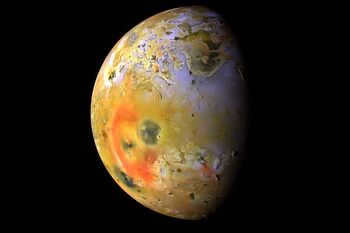
Centers on a celestial body
Weight
As we delve further into the arrangement, we unearth a plethora of enigmas. The four most sizable satellites of Jupiter, known as the Galilean moons, have emerged as the most captivating. Io garners fascination due to its volcanic behavior (with over 400 active volcanoes).
Discovery and Naming
In 1610, Galileo Galilei made the discovery of this satellite using his newly invented telescope. However, he initially mistook it for Europa and only saw it as a single point of light. It was only the following day that he observed separate bodies.
In 1614, Simon Marius also claimed to have observed these satellites. Interestingly, it was his names that were officially adopted, as they were previously only designated with Roman numerals.
Io, the satellite in question, was named after the mistress of Zeus. She hailed from the lineage of Heracles and served as a priestess in Hera’s temple. All of Io’s features were given names associated with fire, thunder, as well as characters and places from Dante’s works.
There are currently 225 recorded volcanoes, plateaus, mountains, and major albedos in the IAU database. Some notable features include Prometheus, Twashtar Patera, and Pan Mensa.
Size, mass, and orbit
Europa, with a radius of 1821.6 km and a mass of – 8.93 x 10 22 kg, is approximately 0.266 times the size and 0.015 times the mass of Earth. Its average distance from Jupiter is 421700 km, but its eccentricity of 0.0041 allows it to approach as close as 420000 km and recede as far as 432400 km.
As the innermost satellite in the Galileo group, Europa orbits between Thebes and Ganymede. It is tidally locked to Jupiter, meaning that one side always faces the planet.
Europa completes its orbital path in 42.5 hours and has resonances of 2:1 with Europa and 4:1 with Ganymede. These resonances have influenced its eccentricity and have been a significant factor in its heating and geologic activity.
Composition and Surface
Io surpasses all other moons in the system with its density of 3.528 g/cm3. Its makeup consists of a combination of silicate rock and iron, resembling Earth-type planets. The majority of its mass is comprised of a crust and mantle rich in silicates, while the core is primarily composed of iron and iron sulfide. The iron sulfide accounts for approximately 20% of the moon’s mass and extends about 350-650 km in radius. However, if the moon also contains sulfur, the radius coverage can increase to 550-900 km.
The mantle of Io is made up of 75% magnesium and contains high levels of iron. The lithosphere, consisting of basalt and sulfur, covers a range of 12-40 km.
The surface of Io is characterized by large former and gray areas, caused by the presence of sulfur dioxide. Atomic sulfur creates yellow and yellow-green regions, while radiation in the polar areas causes sulfur to turn red.
Despite the lack of water on the moon, there are certain areas that still contain ice deposits. The moon’s mountains have an average extension of 6 km, reaching a maximum of 17.5 km on the southern side. These mountains are solitary and do not exhibit any visible global tectonic patterns.
The majority of these mountains are formed as a result of compressions in the lithosphere, which are caused by deep shears.
These mountains come in various shapes and can be seen as plateaus or sloping blocks. Those associated with volcanoes have a similar appearance to shield volcanoes, with steep slopes. However, they are typically smaller in size, measuring around 1-2 km in height and 40-60 km in width.
Volcanoes That Are Currently Active
Right in front of you lies the very first object in the system that is currently experiencing volcanic activity. Its surface is adorned with an array of hundreds of volcanoes and lava flows. These incredible formations not only produce lava flows that can reach heights of 500 kilometers, but they also have a profound impact on the geology of the area.
For instance, massive eruptions give rise to flows that span hundreds of kilometers and are composed of basaltic silicates, iron, and magnesium. Additionally, sulfur, sulfur dioxide, and ash are released into the atmosphere.
The volcanic activity also leads to the creation of numerous depressions that extend for at least 41 kilometers.
The weak layer of the atmosphere is composed of sulfur dioxide, sulfur monoxide, atomic sulfur, sodium chloride, and oxygen. The pressure ranges from 3.3 x 10 -5 to 3 x 10 -4 Pa. On the night side, the pressure can drop to 0.1 x 10 -7 Pa.
The temperature also varies from -163.15°C to -183.15°C, with the maximum reaching 1526.85°C. The density of the atmosphere is highest in volcanic ridges, which leads to replenishment of the atmosphere. Sulfur dioxide is released at a rate of 104 kg per second from volcanic plumes, but most of it condenses on the surface.
Volcanic degassing is the source of elements such as NaCl, SO, S, and O. The interaction of charged particles from Jupiter’s magnetosphere with the satellite’s atmosphere leads to the formation of polar lights. The brightest events are observed near the equatorial line.
Contacting Jupiter’s Magnetosphere
The interaction between Io and Jupiter plays a crucial role in the formation of the planet’s magnetosphere. Jupiter’s powerful gravitational forces strip away material from Io’s atmosphere at a rate of 1 ton per second. This material then forms a neutral cloud around the planet, containing elements such as oxygen, sulfur, sodium, and potassium.
The magnetic field lines of Jupiter intersect with the moon, connecting Io’s atmosphere and neutral cloud with Jupiter’s polar atmospheric layer. This connection creates an electric current, which is responsible for the formation of the stunning auroras observed on Jupiter.
Additionally, the magnetic field lines passing through Io’s ionosphere generate an electric current that can reach up to 400,000 volts. This current, in turn, produces an induced magnetic field. Similar phenomena have also been observed on other moons of Jupiter, known as the Galilean satellites.
Exploration of Jupiter
In 1973, Pioneer-10 and Pioneer-11 made the first-ever flybys of Jupiter, providing valuable information about its mass, composition, density, atmosphere, and radiation belts.
Then, in 1974, the Voyagers 1 and 2 flew past Jupiter, capturing improved images and revealing its vibrant colors. The data collected also revealed the presence of sulfur and active volcanoes on the planet’s surface.
In 1995, the Galileo spacecraft arrived at Jupiter, conducting a close approach on December 7. Galileo closely observed volcanic eruptions, analyzed the planet’s composition, and documented surface changes since the previous Voyager missions.
The mission saw two extensions in 1997 and 2000. During this period, Galileo made 6 flybys of Io, enabling a clear understanding of its geological processes and ruling out the presence of a magnetic field.
In 2000, Cassini approached and then moved further away from the Jupiter system, facilitating a collaborative study. This collaboration led to the identification of a new plume and enhanced comprehension of the auroras.
In 2007, New Horizons made a flyby of the system, capturing numerous images of the surface, plumes, and newly discovered jets.
In 2011, the Juno spacecraft was launched and is currently tracking the planet and its satellites. The presence of volcanic activity can be monitored using an infrared spectrometer. In 2022, the JUICE mission may be launched, offering the ability to observe volcanoes for a duration of 2 years before entering orbit around Ganymede.

